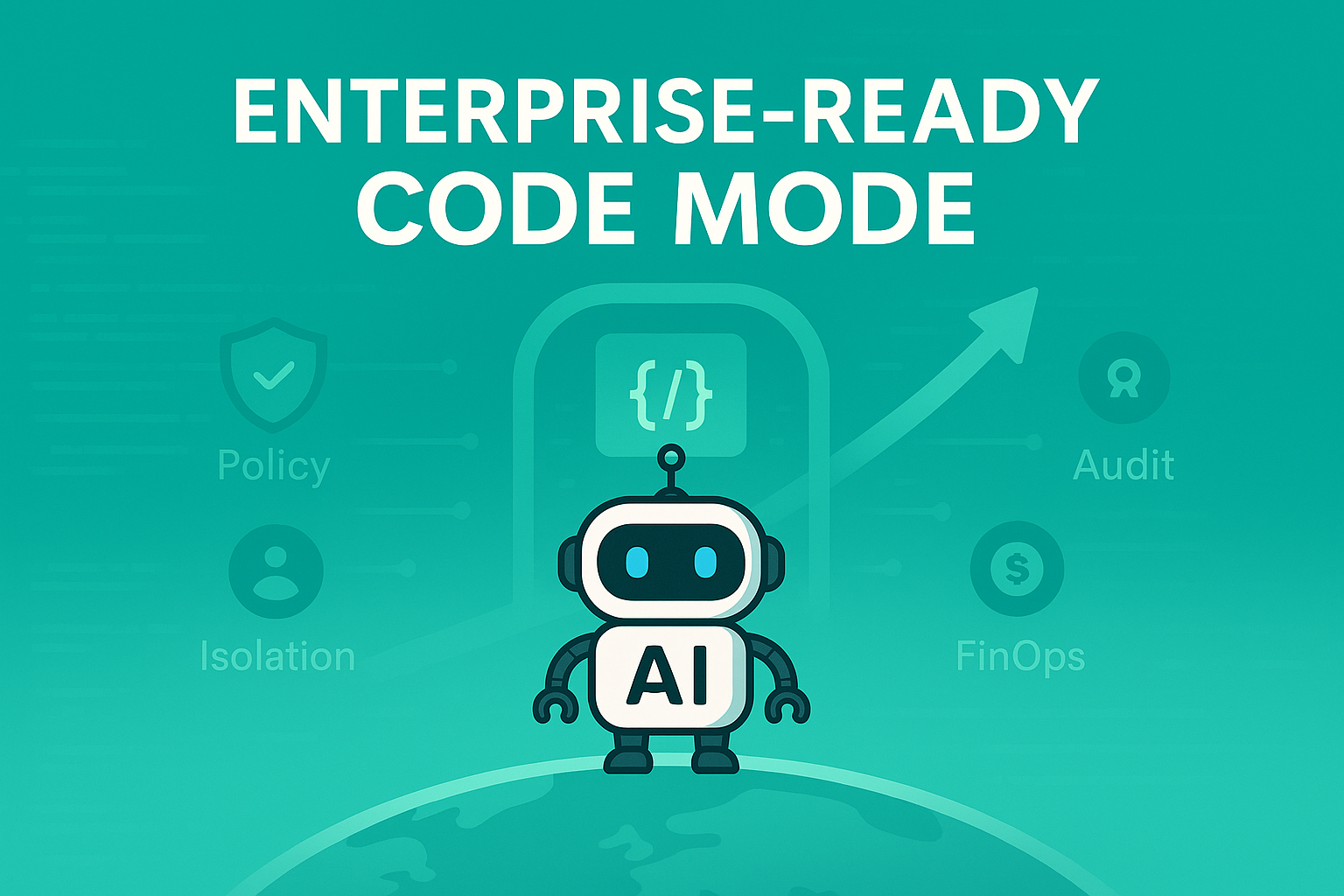Short version: Code Mode turns multi-hop agent flows into deterministic code that runs in isolates and calls only approved MCP tools. The payoff is higher accuracy, lower token spend, and real governance. Cloudflare helped popularize the pattern (convert MCP tools into a typed API, have the model write code, execute it in a sandboxed environment). Anthropic's engineering team explains why this reduces context bloat and errors when used with MCP. Palma.ai brings those ideas to the enterprise—on-prem, no vendor lock-in, with policy, audit, and cost controls at the tool boundary.
A crisp definition (for searchers and skimmers)
Code Mode (for MCP) presents your MCP tools as a clean language API. The model writes code against that API. That code executes inside an isolate whose only capability is to call policy-approved MCP tools—not your filesystem and not the open internet. The agent returns a single governed result instead of dragging every intermediate through the model. This matches Cloudflare's "typed API + sandbox" framing and Anthropic's "code execution with MCP" guidance to load tools on demand and keep intermediates out of the prompt.
Why the industry is moving this way
Cloudflare's "Code Mode" shows that models are better at writing code to use tools than at invoking tools hop-by-hop. Converting MCP schemas to a TypeScript-style API and executing generated code in a sandbox reduces mistakes and composes many tools more reliably. Anthropic independently argues for code execution with MCP: load only the tools you need, filter bulky intermediates before they hit the model, and handle complex logic in a single step—lowering tokens and latency. Palma.ai aligns with both ideas but adds the controls, isolation, and observability enterprises need.
Palma.ai Code Mode: enterprise governance, on-prem, no lock-in
Palma.ai operationalizes Code Mode as an enterprise control plane you can run on-prem or inside your VPC. You keep your model keys, your data, and your policies—and you can switch model vendors without rewriting chains because MCP is an open standard.
Palma.ai enforces policy at the tool boundary (RBAC, scopes, quotas) and executes orchestration inside isolates with a minimal capability surface. The only thing the code can do is call allow-listed MCP tools through Palma.ai's governed bindings. Every plan, code hash, tool invocation, and decision is logged for audit, and you get FinOps visibility out of the box (tokens per completed task, first-try success rate, time-to-finish, and cost per successful action). Anthropic's efficiency rationale and Cloudflare's API-first framing are the backdrop; Palma.ai makes it deployable—safely—at enterprise scale.
Avoid vendor lock-in by design
Enterprises want leverage, not handcuffs. With Palma.ai, your tools are MCP servers, not proprietary plugins, so they remain portable across clouds and runtimes. Bring your own models (SLMs or frontier) and change providers over time—client-side code generation means keys and sensitive data stay under your control. Because Palma.ai is self-hostable, governance never leaves your perimeter.
On-prem first (without compromises)
Deploy Palma.ai in your VPC or data center, integrate with your IdP/SIEM/secret store, and isolate teams and environments with Virtual Servers. Highly restricted networks are supported via air-gapped mode with offline policy bundles and deferred log shipping. The reference architecture is explicitly designed for on-prem and VPC-isolated operation with zero external cloud dependencies in the control path.
Where Code Mode beats sequential tool-calling
Sequential calls are brittle: each hop is another chance to pick the wrong tool or pass the wrong payload. Code Mode turns that chain into one governed unit of work. Accuracy improves because orchestration is deterministic; cost and latency drop because you generate code once and execute once; operations get simpler because you audit a single transaction. Anthropic's write-up highlights the token/latency wins when intermediates stay out of the prompt and logic runs in an execution environment.
What Palma.ai tracks (and shows): tokens per completed task, first-try success rate for multi-hop chains, time-to-finish , and cost per successful action (with showback/chargeback). These KPIs roll up in dashboards so accuracy, speed, and spend are visible to both builders and governance.
SLM-ready, by design
Because Palma.ai shifts "reason through every hop" into execute a clear script, small language models (SLMs) become far more useful. Prompts stay tiny (plan + needed tool types), retries fall, and throughput with latency stabilizes. You can keep everything on-prem, using private SLMs for planning/execution and escalating to larger models only where they add real value—precisely the efficiency pattern Anthropic describes for code execution with MCP.
How Palma.ai Code Mode works (end-to-end)
First, the agent produces a function plan—a compact description of what to do, scoped to your allow-listed tools. Your environment's model then turns that plan (plus tool type definitions) into executable code. Palma.ai runs that code inside an isolate with no filesystem or network access; its only capability is to call approved MCP tools through governed bindings. Policies execute at the tool boundary, calls are validated and recorded, and the agent receives a single, predictable completion. This mirrors Cloudflare's API-centric pattern and Anthropic's MCP guidance, adapted for enterprise control.
When Palma.ai Code Mode is the right move
Choose Palma.ai Code Mode when your workflow spans multiple tools (enrich → transform → validate → write), when you need determinism (idempotent writes, explicit validation, human-in-the-loop gates), when you must prove what ran (policy + audit), and when you want on-prem/SLM economics without committing to a single model vendor. Code Mode is the shortest path from "agent attempts" to "agent outcomes."
Benefits of using Palma.ai
For Agent Builders
Palma.ai shortens the distance from idea to reliable execution. You write less glue, ship chains that finish on the first try, and debug a single, auditable unit of work instead of a dozen brittle hops. Because orchestration compiles to code inside isolates, you get smaller prompts, fewer retries, and the freedom to use SLMs on-prem—escalating to larger models only when they add clear value. And you don't have to guess what exists: Palma.ai provides MCP discoverability—a governed, searchable catalog of tools, resources, and prompts across all registered servers (kept current by discovery jobs), with full-text, fuzzy, and optional semantic search. Virtual Servers unify multiple back-ends behind one logical endpoint so you can find and test the right tool in seconds.
For Platform Teams
Palma.ai centralizes control at the tool boundary. You define policies (RBAC, scopes, quotas), isolate environments with Virtual Servers, and keep keys and data local thanks to client-side code generation. Tool catalogs remain portable under MCP, cost is visible with FinOps dashboards, and every decision or call is preserved for audit. You can run it self-hosted or air-gapped without losing observability.
For MCP Builders
Palma.ai gives you a clean, standardized way to expose internal systems as MCP tools without tying yourself to a single agent runtime or cloud. The contract is crisp: schemas, scopes, and policies are enforced consistently; upgrades are predictable; support tickets drop. Because Palma.ai is vendor-neutral and on-prem friendly, your services stay portable while gaining the guardrails enterprises expect.



